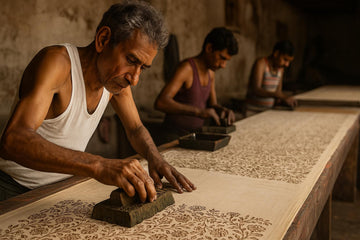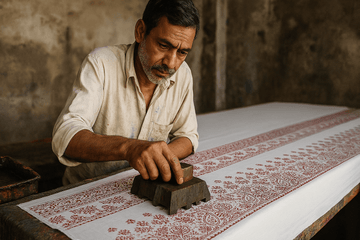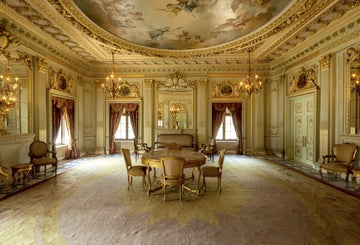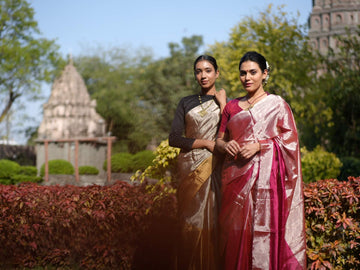
India is home to a rich variety of hand-block printing traditions, each rooted deeply in its regional culture, history, and natural resources. Here's a comprehensive list of the major block printing crafts of India, like Bagru, along with their unique features:
🟠 1. Bagru Printing – Rajasthan
-
Region: Bagru, near Jaipur, Rajasthan
-
Specialty: Earthy tones, floral and bootis, use of natural dyes (red, black, indigo, yellow)
-
Technique: Dabu resist printing, mud-resist techniques, wooden block motifs
-
Community: Chhipa community
-
Motifs: Floral vines, mango (ambi), leheriya (waves), bootis
🔵 2. Sanganeri Printing – Rajasthan
-
Region: Sanganer, Rajasthan (close to Bagru but distinct in style)
-
Specialty: Fine lines, delicate floral patterns, white or light background
-
Technique: Use of wooden blocks with highly intricate carving
-
Dyes: Initially natural, now often synthetic
-
Motifs: Mughal-inspired floral sprays, leaves, jasmine, rose, lotus
🟢 3. Ajrakh Printing – Gujarat & Rajasthan
-
Region: Kutch (Gujarat) and Barmer (Rajasthan)
-
Specialty: Symmetrical geometric designs, indigo and madder red, complex 14-16 step process
-
Technique: Resist dyeing, use of natural mordants and vegetable dyes
-
Artisan Community: Khatri community
-
Motifs: Stars, grids, circular mandalas, Islamic geometric patterns
🔴 4. Kalamkari Block Printing – Andhra Pradesh
-
Region: Machilipatnam, Andhra Pradesh (distinct from free-hand Kalamkari of Srikalahasti)
-
Specialty: Mythological and religious storytelling through prints
-
Technique: Vegetable dyes, outlines drawn with blocks, filled by hand or screen
-
Motifs: Ramayana, Mahabharata scenes, deities, temple art
🟣 5. Bagh Printing – Madhya Pradesh
-
Region: Bagh, Dhar district, MP
-
Specialty: Rich red and black prints on white/off-white backgrounds, symmetrical patterns
-
Technique: Hand-carved blocks, river washing, natural dyeing
-
Motifs: Geometric, floral, tribal, jali-inspired patterns
-
Community: Khatris of Bagh
🟤 6. Dabu Printing – Rajasthan
-
Region: Akola, Bhilwara, and other parts of Rajasthan
-
Specialty: Mud-resist printing technique, deep indigo and earthy tones
-
Technique: Layers of mud mixed with gum applied before dyeing, creating resist patterns
-
Motifs: Dots, lines, paisleys, bootis
-
Note: Often combined with Bagru or Sanganeri motifs
⚪ 7. Saudagiri Printing – Madhya Pradesh
-
Region: Near Burhanpur, MP (revival craft)
-
Specialty: Finer outlines, Islamic and Persian influence
-
Motifs: Ornamental, often used on prayer mats and ceremonial fabrics
🟡 8. Tikuli and Mithila-Inspired Block Printing – Bihar
-
Region: Bihar
-
Specialty: Integration of Madhubani-style motifs into block prints
-
Technique: Revival efforts combining traditional painting styles with block motifs
🟧 9. Serampore & Baluchari Block Prints – West Bengal
-
Region: Serampore (Hooghly) & Murshidabad
-
Specialty: Revival attempts of older Baluchari themes in printed formats
-
Motifs: Folk, temple stories, paisleys, narrative panels
🟩 10. Chittara & Lambani-Inspired Block Prints – Karnataka
-
Region: Northern Karnataka
-
Specialty: Tribal-inspired geometric motifs from the Lambani and Chittara traditions
-
Note: Mostly revival efforts by NGOs and textile collectives
🟤 11. Batik Printing – West Bengal, Gujarat, Tamil Nadu
-
Technique: Wax-resist dyeing + block application
-
Unique Feature: Blocks are used to apply hot wax to areas of fabric that are to remain undyed. Multiple layers create intricate, crackled textures.
-
Colors: Bright and bold – yellows, blues, greens
-
Regions: Shantiniketan (West Bengal), Mundra (Gujarat), and parts of Tamil Nadu
-
Fun Fact: While Indonesia is most famous for Batik, India has adapted it with regional flavors!
🟥 12. Tarapur Prints – Madhya Pradesh
-
Technique: Similar to Bagh but faster, using both natural and synthetic dyes
-
Motifs: Geometric and repetitive floral prints
-
Current Use: Dupattas, dress material, stoles
-
Interesting Insight: Tarapur is evolving as a Bagh alternative for quicker production with modern twists.
🟡 13. Nathdwara Pichwai Printing – Rajasthan
-
Technique: Block prints inspired by the intricate Pichwai paintings used in temples
-
Motifs: Cows, lotuses, Shrinathji (Krishna) forms, and temple iconography
-
Use: Often seen in festive décor, high-end fashion, and home linens
-
Note: Pichwai print is a growing trend among designers for storytelling-based fashion
🟣 14. Dindori Tribal Prints – Madhya Pradesh (Revival Craft)
-
Technique: Hand-block prints developed with tribal Gond or Baiga motifs
-
Specialty: Stylized birds, trees, and folk tales
-
Support: Often run through tribal cooperatives and NGOs to support artisan livelihoods
🟩 15. Kutch Block Printing – Gujarat
-
Distinction from Ajrakh: While Ajrakh is more formal and precise, other Kutch block prints often feature bold patterns and faster processes using semi-natural dyes.
-
Motifs: Peacocks, elephants, desert flora
-
Use: Dupattas, bedspreads, tourist textiles
🟠 16. Tikuli Art Block Printing – Bihar
-
Fusion of Tikuli painting style with block-printed outlines and filled with vibrant hand-painting or dye
-
Modern Revival: Being explored for fashion accessories and decor
Honorable Mentions & Lesser-Known Traditions:
-
Pethapur (Gujarat) – Traditional block carving hub supplying blocks across India
-
Nagaur (Rajasthan) – Block printing with religious/ritual significance
🌍 Famous Global Block-Printing Traditions
| Country | Region/Craft | Specialty |
|---|---|---|
| China | Early textile block printing | Oldest recorded use of blocks (Tang Dynasty) |
| Japan | Katazome and Yuzen | Stencil + resist dye block prints, used in kimono |
| Indonesia | Batik Cap | Wax-resist + copper block stamps |
| Turkey | Tokat Yazması | Floral wooden block prints, Ottoman heritage |
| Iran | Qalamkar prints | Persian block-printed textiles with floral medallions |
| Africa | West African Adire Eleko | Indigo-resist techniques, block patterns with cultural symbolism |
| Uzbekistan | Kalamkari (local version) | Similar to Indian Kalamkari via Silk Road links |
🌟 Final Thoughts: A Legacy Inked in Time
From the narrow lanes of Bagru to the silk looms of China, from Ajrakh’s sacred geometry to Batik’s wax-kissed florals — hand-block printing is a universal language spoken by hands, not words.
It connects continents. It transcends time.
In a world racing ahead, this slow, deliberate art reminds us of something primal — that beauty lies in the human touch.
So next time you drape a Bagru dupatta or see a Batik skirt, remember: someone carved that block. Someone stamped it, one press at a time. And someone, somewhere, is keeping a 2000-year-old story alive — just for you.




